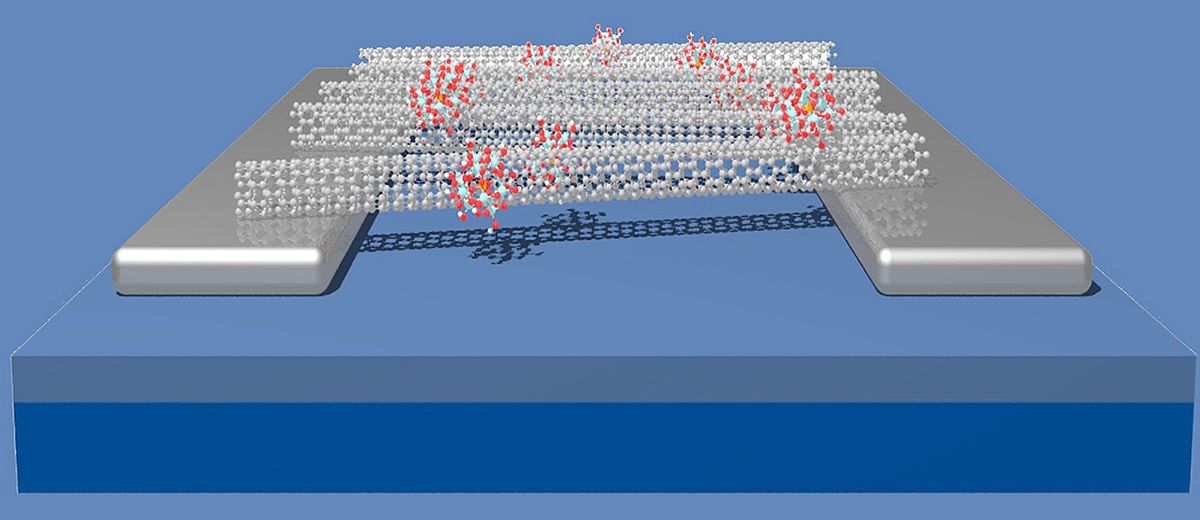It seems counterintuitive that background noise—like a white noise—could actually be used to help detect faint signals. But that’s what happens in an unexpected phenomenon known as stochastic resonance (SR). We see it in use helping people keep their equilibrium or paddlefish locating plankton in muddy waters.
Now researchers at Osaka University in Japan have developed a SR-based electronic device that could potentially usher in a new era in bio-inspired sensors and new approaches to computing. The key to the device is the use of single-walled carbon nanotubes (SWNTs) and phosphomolybdic acid (PMo12) molecules. The combination creates a constant buzzing of movement.
For a SR-based electronic device to function, it needs both a signal detection threshold and additional noise. In research described in the journal Applied Physics Letters, the Japanese researchers achieved both by first aligning 300 SWNTs in parallel to each other and then placing the group in between two chromium electrodes.
The SWNTs generate their own noise because of their high sensitivity to external surface disturbance, while the two chromium electrodes simply enhance the signal detection capability.
When the PMo12 molecules are added to the SWNTs, they serve as an extra disruptor to the SWNTs through the process of molecular adsorption. This adsorption generates a large and tunable type of electrical noise in addition to common environmental noise.
“Our system consists of signal detection threshold at the interface between SWNT and electrode, and the system is multiplied by the number of SWNTs,” said Megumi Akai-Kasaya, assistant professor at Osaka University, in an e-mail interview with IEEE Spectrum. “Our system also provides the noise, which helps in the signal being detected.”
The process of PMo12 molecules adsorbing on the surface of the SWNTs is the key physical phenomenon of the device.
“When the PMo12 molecules come in contact with the electron sea of the SWNTs, they act as a charge trap site that flickers at room temperature,” said Akai-Kasaya. “Then these trapped charges act as a point gate for semiconducting SWNT-based field emission transistors (FETs). The flicker of the charge trapping and de-trapping makes noise in current flows throughout the SWNT. This is the reason of noise generation of PMo12 molecules.”
So a little random noise can amplify a signal so that a little vibration in someone’s fingers can enhance their sense of touch. But how does this all translate into approaches to computing?
It all goes back to biology again. Akai-Kasaya explains that the stochastic computation in our brain is considered one of the origins of intelligence, and the noise should help hyper low energy consumption of the brain.
“Currently artificial intelligence (AI), artificial neural network, and deep learning do not use stochastic computation,” said Akai-Kasaya. “But AI researchers are now developing stochastic computation.”
Some of these AI developments are technologies such as the Boltzmann machine, which is a kind of neural network based on stochastic principles and spiking neural networks, both of which involve the combining of stochastic fluctuations.
The development of the neuromorphic computing hardware is still in its early stages. (IEEE Spectrum produced a special report on this general field earlier this year: Can We Copy the Brain?) Akai-Kasaya believes that noise generation devices will be needed in such future hardware to realize neuromorphic stochastic computation or to realize hyper low energy consumption informational transfer.
In continuing research, Akai-Kasaya is pursuing these aims of neuromorphic stochastic computation by constructing neural network hardware using another material other than SWNTs.
He adds: “I would like to demonstrate that a neural network consisting of nanomaterials capable of spontaneous fluctuation as we have shown will have new functionality.”
Dexter Johnson is a contributing editor at IEEE Spectrum, with a focus on nanotechnology.



